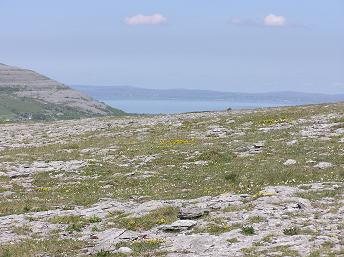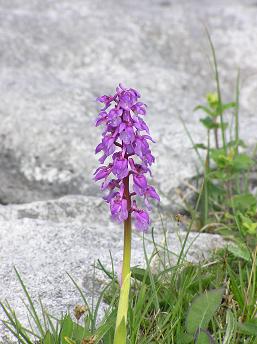Burren...

The Burren is the central region of North Clare it covers the land between the villages of Ballyvaughan, Corofin, Doolin, Kilfenora and Gort. Each year people with all levels of expertise, from the casual tourist to the dedicated botanist roam this lunar landscape. They are richly rewarded with a remarkable mixture of Arctic, and Mediterranean flora which grow in profusion amid the plant communities of the Burren. This coupled with numerous species of butterflies adds to the richness and colour of the place,
The appeal of the Burren flora lies in the co-existence of different ecological species growing side by side. Plants that would normally grow on high mountain tops grow here at sea level harmoniously with Mediterranean varieties, lime loving and acid loving plants grow adjacent to one another and woodland plants grow out in the open without a tree in sight for miles. There is nowhere else in Europe where Mediterranean and arctic-alpine plants grow together in a similar way. The rich array of plants includes; Mountain Avens (Dryas octopetala) Spring Gentian (Gentiana verna) Hoary Rockrose (Helianthemum canum) Milkwort (Polagala vulgaris) and many more.

The nature of the terrain and the traditional methods of farming have left the Burren unspoilt. A wide range of fauna thrives in this undisturbed region. Irish hare, rabbit, feral goat, bats, fox, badger, pine martin, stoat and red squirrel are all commonly spotted.
The Burren is renowned for its archaeology Ballyvaughan is surrounded by megathlithic tombs such as Poulnabrone Dolmen, celtic ring forts such as Caherconnell , and medieval churches, and castles. From the results of research and excavations a good deal of information has been gathered on the pattern of life and death of these early settlers. The tombs of these first farmers, described as 'megalithic', which means 'great stones', are impressive monuments over the graves of their dead. By and large the most outstanding tomb from that period is the portal dolmen at Poulnabrone, it dates from c.3600 BC. Caherconnell Stone Fort is an exceptionally well preserved Celtic ring fort (ancient protected family homestead).This fort and other sites like it would have been inhabited from around 500 to 1500AD.
In the Burren one can observe almost all the typical limestone landforms; underground rivers, swallow holes, glacial erratics, caves, clints, grykes and closed depressions (turloughs). The main action of the glacier was to scour the rock clean off any superficial cover that formerly laid on the surface, thus exposing and smoothly polishing the underlying bedrock. The name Burren comes from Gaelic, meaning 'a rocky place'
Visitors may explore this unique landscape by car, bike or hiking on its many hills. The beaches and coast line of the Burren are ideal for swimming, boating and fishing. There are many types of accommodation available near the Burren from hotels to self-catering bed and breakfasts and hostels. The pubs in the region provide a wide variety of entertainment with traditional music being popular and the area is home to a number of fine restaurants.